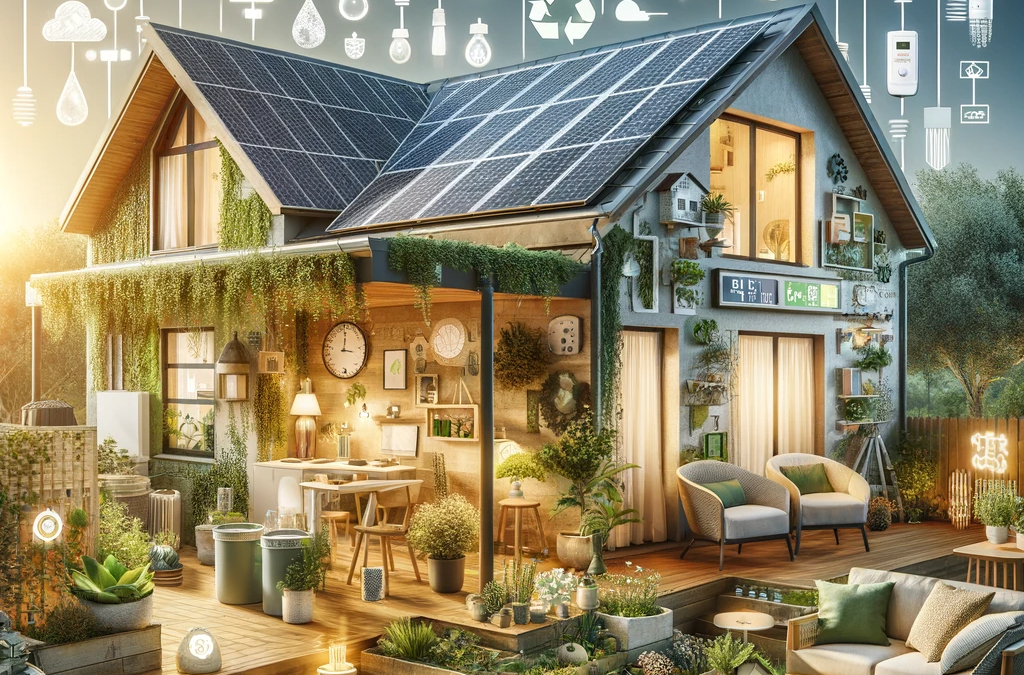In an era where environmental consciousness is more important than ever, making eco-friendly home improvements is not just a trend – it’s a necessity. Transforming your living space into a green sanctuary not only benefits the planet but can also enhance your quality of life. Let’s explore how you can create a more sustainable and eco-friendly home.
Understanding the Impact of Eco-Friendly Living
The concept of eco-friendly living extends beyond mere recycling. It’s about reducing our carbon footprint and creating a living space that harmonizes with the environment. Sustainable home improvements can significantly reduce energy consumption, lower bills, and minimize environmental impact.
1. Embracing Renewable Energy
One of the most impactful ways to green your home is by investing in renewable energy sources. Solar panels are a popular choice, providing a clean, renewable source of energy and significantly reducing electricity costs in the long run.
2. Energy-Efficient Lighting
Switching to LED lighting is a simple yet effective eco-friendly improvement. LEDs are more energy-efficient than traditional bulbs, consume less power, and have a longer lifespan, reducing both your energy bill and waste.
3. Sustainable Insulation
Good insulation is key to energy efficiency. It keeps your home warm during winter and cool in summer, reducing the need for excessive heating and cooling. Consider materials like sheep’s wool, recycled denim, or cellulose for sustainable insulation.
4. Eco-Friendly Appliances
Invest in energy-efficient appliances. Look for products with high Energy Star ratings – these appliances use less energy and water, reducing your utility bills and conserving natural resources.
5. Water Conservation
Implementing water-saving measures is crucial. Install low-flow showerheads, faucets, and toilets to reduce water usage. Consider a rainwater harvesting system for garden irrigation and other non-potable uses.
6. Green Gardening
Transform your outdoor space into a green oasis. Planting native plants and trees not only beautifies your space but also supports local biodiversity. Start a compost bin for organic waste, which can be used to enrich your garden soil.
7. Maximizing Natural Light
Utilize natural light to reduce reliance on artificial lighting. Large windows, skylights, and strategically placed mirrors can brighten your home naturally, making it more energy-efficient and welcoming.
8. Eco-Friendly Flooring
When it comes to flooring, sustainable options include bamboo, cork, or reclaimed wood. These materials are not only environmentally friendly but also add natural beauty and warmth to your home.
9. Non-Toxic Paints
Use eco-friendly, non-toxic paints. Traditional paints often contain harmful chemicals and volatile organic compounds (VOCs). Eco-friendly paints are safer for your health and the environment.
10. Smart Home Technology
Smart home technologies like programmable thermostats and energy monitors can help you manage your home’s energy usage more effectively. These devices provide real-time feedback and control, allowing you to optimize energy consumption.
Additional Tips for a Greener Home
- Recycle and Upcycle: Before buying new, see if you can repurpose or upcycle existing items.
- Buy Locally: Support local businesses and reduce carbon emissions associated with transportation.
- Energy Audits: Consider a professional energy audit to identify areas where you can improve energy efficiency.
- Mindful Consumption: Be conscious of what you buy and bring into your home. Opt for products with minimal and recyclable packaging.
The Benefits of Going Green
The benefits of eco-friendly home improvements extend beyond environmental impact. They can lead to significant financial savings over time, improve indoor air quality, and create a more comfortable and aesthetically pleasing living environment.
Engaging the Community
Eco-friendly living doesn’t have to stop at your doorstep. Engage with your community on sustainability initiatives. Whether it’s community gardening, clean-up drives, or sharing resources, collective efforts have a more significant impact.
The Challenge of Initial Costs
While some green improvements can be costly upfront, it’s important to consider the long-term savings and environmental benefits. Many governments offer incentives and rebates for eco-friendly home upgrades, which can help offset initial costs.
A Step Towards a Sustainable Future
Creating an eco-friendly living space is a step towards a more sustainable future. It’s a commitment to living in harmony with our environment and a responsibility we all share. By making these changes, we not only contribute to the health of the planet but also to our well-being and that of future generations.
As you embark on your journey to a greener home, remember that every small change counts. From simple swaps to significant renovations, each step you take is a stride towards a more sustainable lifestyle. Embrace the eco-friendly transformation and enjoy the peace of mind that comes with knowing you’re making a difference. 🌿🏡💚
Unlock Full Article
Watch a quick video to get instant access.


Social Media